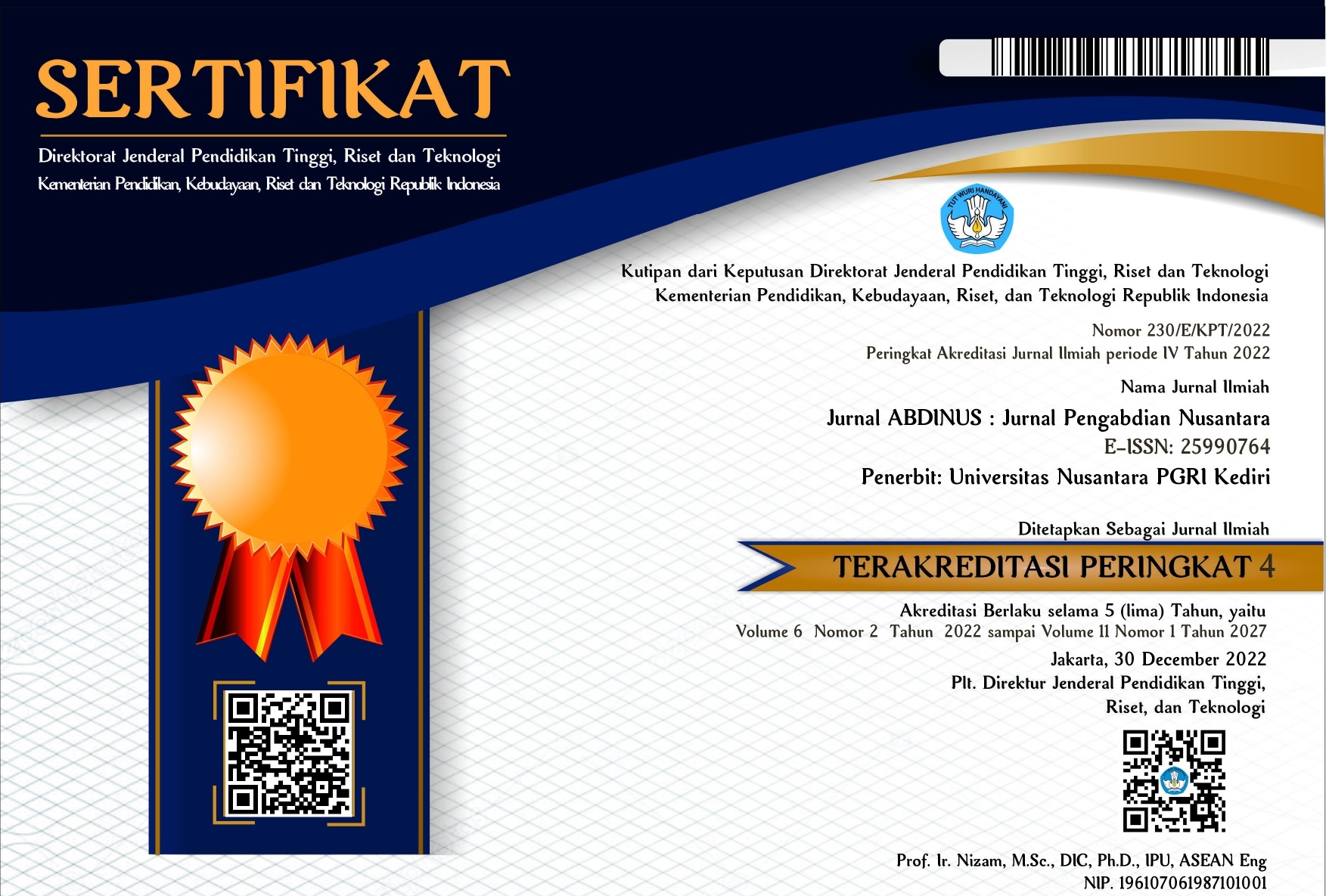Program Pengintegrasian Teknologi dalam Pembelajaran untuk Guru SD/MI Kecamatan Karangploso Kabupaten Malang
DOI:
https://doi.org/10.29407/ja.v6i2.17704Keywords:
Training, Learning Videos, Learning MediaAbstract
The purpose of this technology integration program in learners is to learn about how to make interesting learning videos and apply e-learning. It is hoped that in this community service activity, teachers can master interactive and interesting learning media in the form of learning videos and apply them to e-learning. The implementation of this community service activity is in the form of presentations regarding the introduction of learning media, OBS software, e-learning, and how to make learning videos. The method used is the preparation of materials and software, implementation methods related to how to operate OBS software, and e-learning and practical methods are carried out in the form of making interactive learning video media according to the material taught by the teacher. The evaluation was carried out in this training by observing the differences in the skills of teachers in making learning videos after the implementation of the training. Based on the results that have been achieved. The evaluation of the results training was assessed from the participation and practical assignments of making interactive videos according to the material taught by the teacher. Then the results of making interactive learning videos are implemented in the schools of each SD/MI teacher.
Downloads
References
Carrillo, C., & Flores, M. A. (2020). COVID-19 and teacher education: a literature review of online teaching and learning practices. European Journal of Teacher Education, 43(4), 466–487. https://doi.org/10.1080/02619768.2020.1821184/FORMAT/EPUB
Clark R.C. & Mayer, R. E. (2008). E-learning and the science of instruction: proven guidelines for consumers and designers of multimedia learning, second edition, San Francisco: John Wiley & Sons, Inc.
Merdekawati, P., & Christiana, E. (2019). Penerapan Layanan Bimbingan Klasikal Menggunakan Media Video untuk Meningkatkan Motivasi Belajar Siswa Kelas VIII di SMP Negeri 2 Wringinanom Gresik. Jurnal BK UNESA, 10(1)
Munir. (2009). Pembelajaran Jarak Jauh berbasis Teknologi Informasi dan Komunikasi (TIK). Retrieved from www.cvalfabeta.com
Rapanta, C., Botturi, L., Goodyear, P., Guàrdia, L., & Koole, M. (2020). Online University Teaching During and After the Covid-19 Crisis: Refocusing Teacher Presence and Learning Activity. Postdigital Science and Education 2020 2:3, 2(3), 923–945. https://doi.org/10.1007/S42438-020-00155-Y
Rusman, D. K., & Cepi, R. (2012). Pembelajaran berbasis teknologi informasi dan komunikasi: mengembangkan profesionalitas guru. . Jakarta: Rajawali Pers.
Rusman, dkk. (2011). Pembelajaran berbasis teknologi informasi dan komunikasi, mengembangkan profesionalitas guru. Jakarta: PT. Raja Grafind.
Saffudin. (2013). Pengembagan E-learning Pendidikan Kewarganegaraan Berbasis Moodle di SMA Lampung Selatan. Jurnal Teknologi Informasi Komunikasi, 1(3), 1–12.
Smaldino, S. E. ; (Deborah L. L. J. D. R. (2012). Instructional technology and media for learning = teknologi pembelajaran dan media untuk belajar (Ed. ke 9, cet. 2). Kencana.
Yendrita, Y., & Syafitri, Y. (2019). Pengaruh Penggunaan Media Video Pembelajaran terhadap Hasil Belajar Biologi. BIOEDUSAINS: Jurnal Pendidikan Biologi Dan Sains, 2(1), 26-32
Yudianto, Arif (2017) Penerapan Video sebagai Media Pembelajaran. In: Seminar Nasional Pendidikan 2017, Sukabumi.
Zahroh, N. L. (2015). E-Learning Sebagai Inovasi dalam Pembelajaran IPS Tantangan dan Peluang. Seminar Nasional Teknologi Pendidikan UM, 498–509.















